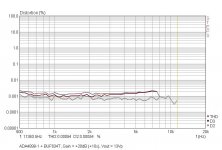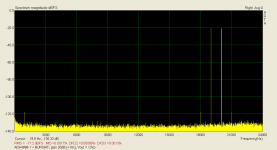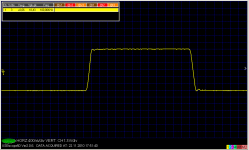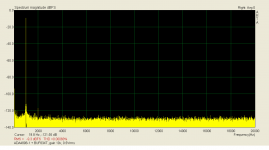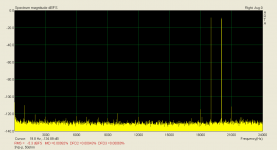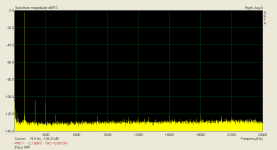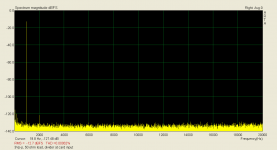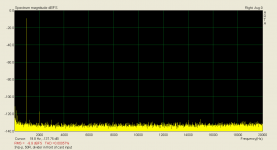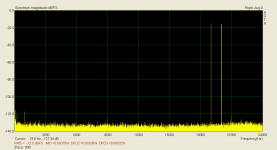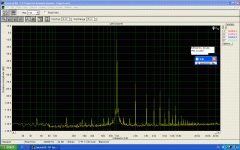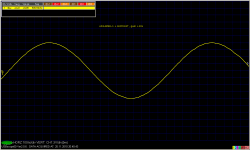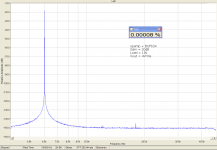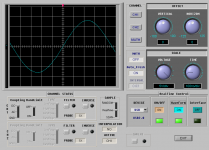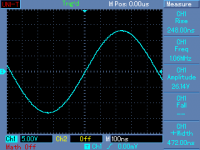I made some modifications of my 8 years old project, that can be seen in
Audio Buffer in english
Please forgive the old text, I would write it quite different today 😉
Anyway - what are the current mods. I needed gain, so now I have the gain of +10x, i.e. 20dB. I decided to use Analog Devices ADA4898-1 opamp. This is a very nice part, which has very very low noise 0.9nV/rtHz, enough slew rate of 55V/us and very low distortion up to 100kHz.
Some distortion results measured just below clipping, and 100kHz square response in 400ns/div:
Audio Buffer in english
Please forgive the old text, I would write it quite different today 😉
Anyway - what are the current mods. I needed gain, so now I have the gain of +10x, i.e. 20dB. I decided to use Analog Devices ADA4898-1 opamp. This is a very nice part, which has very very low noise 0.9nV/rtHz, enough slew rate of 55V/us and very low distortion up to 100kHz.
Some distortion results measured just below clipping, and 100kHz square response in 400ns/div:
Attachments
Hi Pavel, Thanks for the update.
I have a question about the choice of the buffer and any advantage it has over single or parallel opamps, in the same position. Given that distortion levels in current opamp designs are also considerably lower, is there a particular reason to use it?
I have a question about the choice of the buffer and any advantage it has over single or parallel opamps, in the same position. Given that distortion levels in current opamp designs are also considerably lower, is there a particular reason to use it?
Ian,
please take into account that the plots are for gain 20dB, and 13Vp. Also, take into account CCIF 19+20kHz plot, and the time plot in 400ns/div.
For 5Vrms, I get 0.00068%, which is just the bottom I am able to measure, so in fact I do not know distortion at 5Vrms.
IMO buffering is very important.
1) you have high output stage idle current (15mA in this particular case)
2) you are able to drive any capacitive load, and resistor load down to 100ohm. This may sound useless, but rugged output IS important.
3) the output is immune to HF EMI interference
This goals are very important for my design philosophy, and sonic result is much better with buffer, to me. It just works 😉
The opamp used is http://www.analog.com/static/imported-files/data_sheets/ADA4898-1.pdf
to me this one of the best opamps for audio ever designed.
Regards,
please take into account that the plots are for gain 20dB, and 13Vp. Also, take into account CCIF 19+20kHz plot, and the time plot in 400ns/div.
For 5Vrms, I get 0.00068%, which is just the bottom I am able to measure, so in fact I do not know distortion at 5Vrms.
IMO buffering is very important.
1) you have high output stage idle current (15mA in this particular case)
2) you are able to drive any capacitive load, and resistor load down to 100ohm. This may sound useless, but rugged output IS important.
3) the output is immune to HF EMI interference
This goals are very important for my design philosophy, and sonic result is much better with buffer, to me. It just works 😉
The opamp used is http://www.analog.com/static/imported-files/data_sheets/ADA4898-1.pdf
to me this one of the best opamps for audio ever designed.
Regards,
Last edited:
I agree with you Pavel 100%. Buffering is the key to good sound with Opamps, be the cable long or short, be the termination high impedance or low and this toutches only the surface. Another chip to watch is the LME49990 and the older but good LT1468.
I prefer an open loop buffer though, outside the feedback loop.
I prefer an open loop buffer though, outside the feedback loop.
Pavel, regarding the results above, into what load were the measurements made? Unless the same distortion applies into any load down to your 100 ohm example. I'd be most interested in distortion results into a typical load like headphones, for instance, 32-64 ohms, of an output voltage of about 3V p-p.
The measurements were made at 13Vp/3kohm. I can repeat them at 3Vp-p/32ohm.
I have one measurement at 0.5Vrms, but it just attacks my measurement limit.
I have one measurement at 0.5Vrms, but it just attacks my measurement limit.
Attachments
Last edited:
These 2 measurements are for 50 ohm load at 3Vp-p
________________________
Edit: in fact the result is my soundcard again, and not the buffer. When I add the divider before the card input, I get 0.00062% at 3Vp-p/50 ohm, and I have reached my limits again. The 3rd image.
________________________
Edit: in fact the result is my soundcard again, and not the buffer. When I add the divider before the card input, I get 0.00062% at 3Vp-p/50 ohm, and I have reached my limits again. The 3rd image.
Attachments
Last edited:
I have tried to tune the divider ratio in front of the card input (stepped attenuator with 1.5dB steps), this is the best I can get:
Attachments
Last edited:
Thank you Pavel. I think these are excellent distortion results.
And speaking of that, why would anyone try to do better? It really begs the question, why one would go to the trouble of building a tube headphone amp, hugely inefficient, with every kind of distortion higher than this one? 🙂
If we were to put into volts the amount of 3rd order distortion from the second graph, which looks to be around 105dB down from 3V p-p, it would amount to about 17uV p-p.
May I ask what sound card you're using for these measurements?
And speaking of that, why would anyone try to do better? It really begs the question, why one would go to the trouble of building a tube headphone amp, hugely inefficient, with every kind of distortion higher than this one? 🙂
If we were to put into volts the amount of 3rd order distortion from the second graph, which looks to be around 105dB down from 3V p-p, it would amount to about 17uV p-p.
May I ask what sound card you're using for these measurements?
The soundcard is a cheap M-Audio FastTrack USB. I have to run it 6-12dB under full scale input to get lowest distortion. Also, I often have to use input signal transformer, to convert card input signal to balanced - this is the only way how to keep low distortion of the card at higher frequencies, and to avoid ground loop.
I have to add that I consider distortion as just one of many important parameters. Just one, and not the only one. I want low noise, and the ADA4898 with 0.9V/rtHz is excellent in this. I also require high slew rate and nice step response without breakpoints and oscillations. I want the rising and falling edge of the large signal step response to be same in shape. 55V/us of the AD4898 is just fine. Not less, not 20V/us.
Very good set of results Pavel.
I am currently working on my new pre-amp and that uses the LME49600 buffers Joachim mentions - but in my case they are included in the feedback loop of the op-amp.
I also had the same audio card you had, but could not get decent results for some reason (I used Rightmark). I am looking for another card right now - I heard the ESI Juli is very good, but I don't think they do it as a standalone USB device.
The ADA op-amp you are using has very strange response plots. Seems very much like a current feedback device, althrough they state clearly it is voltage feedback.
I am currently working on my new pre-amp and that uses the LME49600 buffers Joachim mentions - but in my case they are included in the feedback loop of the op-amp.
I also had the same audio card you had, but could not get decent results for some reason (I used Rightmark). I am looking for another card right now - I heard the ESI Juli is very good, but I don't think they do it as a standalone USB device.
The ADA op-amp you are using has very strange response plots. Seems very much like a current feedback device, althrough they state clearly it is voltage feedback.
Hi Bonsai,
thanks for your comments. I also use the buffer inside feedback loop.
Yes, the ESI Juli is very good. But every soundcard needs additional efforts to get reasonable results.
The ADA4898 is definitely a voltage feedback device. The designers overcame many of common opamp drawbacks in this IC design.
Regards,
thanks for your comments. I also use the buffer inside feedback loop.
Yes, the ESI Juli is very good. But every soundcard needs additional efforts to get reasonable results.
The ADA4898 is definitely a voltage feedback device. The designers overcame many of common opamp drawbacks in this IC design.
Regards,
The reason why I do NOT use the buffer out of the FB loop is shown in attached image. When loaded, the distortion becomes very high. This might sound 'rich' to some, but it is undoubtedly incorrect approach. Maybe another out-of-the-loop buffer than 634 would behave better, but I do not believe it would behave perfect.
Attachments
Measurements of the same circuit at 1MHz and full output swing. Now we have both extra low distortion and very fast circuit with very high slew rate above 100V/us. No worries about TIM and PIM ghosts 😉.
The circuit as here: http://web.telecom.cz/macura/buffer_en.html
with gain 20dB.
The circuit as here: http://web.telecom.cz/macura/buffer_en.html
with gain 20dB.
Attachments
Last edited:
This is the earlier OPA134 implementation, right? It's still absolutely capable as a wideband amp, as you indicate. Thanks for the post.
However, I'm not sure how to read the different instrument plots shown when comparing those of your own M-Audio/ARTA system with your colleague's in post #17. I take it that the greatly reduced "grass" at around -150 dB is due to less internal system noise or is some other, perhaps DSP, technique giving the improvement? It certainly is an excellent display, regardless.
For Christmas, I would get one of those instruments..., if only it was affordable!
However, I'm not sure how to read the different instrument plots shown when comparing those of your own M-Audio/ARTA system with your colleague's in post #17. I take it that the greatly reduced "grass" at around -150 dB is due to less internal system noise or is some other, perhaps DSP, technique giving the improvement? It certainly is an excellent display, regardless.
For Christmas, I would get one of those instruments..., if only it was affordable!
That is a fantastic set of results, Pavel.
I do like using op-amps, and if done right, a good op-amp can produce outstanding results - and here we see an example.
I do like using op-amps, and if done right, a good op-amp can produce outstanding results - and here we see an example.
- Status
- Not open for further replies.
- Home
- Source & Line
- Analog Line Level
- Audio Buffer 8 years after
